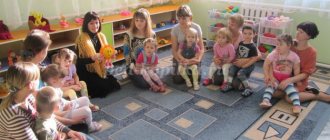Planning work with parents (persons in their stead)
Planning work with parents (persons in their stead).”
Contents and types of planning of the teacher’s work with the family.
Creating a plan for a teacher’s work with a family means developing a project for the educational process, in which the tasks and means of their implementation and achievement are clearly defined.
Planning largely determines the results and effectiveness of the educational system. Purposeful and clear planning helps teachers avoid many mistakes and negative phenomena. A well-founded plan allows you to outline general prospects and specific ways to solve the educational tasks set.
As pedagogical practice shows, a plan is often treated only as an administrative requirement, and the planning process, unfortunately, is limited to the framework of drawing up and writing a plan. With this approach, the plan is undoubtedly of a formal nature and cannot be
61
a guideline for activities. The effectiveness of the results achieved and the success of any activity largely depend on how competently this activity is planned.
The purpose of the plan is to streamline teaching activities, ensure the fulfillment of such requirements for the pedagogical process as planning and systematicity, controllability and continuity of results. In the most general sense, a plan is a document indicating the substantive guidelines for an activity, defining its order, volume, and time boundaries. It performs the following functions:
ü guide, defining, i.e. specific directions and types of activities;
ü predictive, i.e. indirectly reflects the plan, presents results through specific actions;
ü coordinating, organizational, i.e., on the one hand, it reflects how, by what means the activity is organized and who is its subject and object; on the other hand, it indicates the order of activity, its relationship with other types, and also reflects the interaction of subjects of activity, determines its place and time, answers the questions: who, what, when and where should do it;
ü control: firstly, the teacher himself, using the plan, can control the implementation of the goals; secondly, according to the plan it is easy to check how much it corresponds to reality; Moreover, the level and quality of the plan to a certain extent indicate the professional competence of the teacher;
ü reproductive (reproducing), i.e. after any period of time according to the plan, you can restore the content and volume of work completed
work" With proper organization of planning, the plan will become non-formal
paper, but a document that can protect the teacher from unreasonable demands and claims, proving a systematic approach to organizing the pedagogical process. Therefore, first of all, it is necessary to treat the plan as your own working document, which is needed by the teacher himself, and not by the administration, in order to act not chaotically, but in accordance with his plan, goals, capabilities and requirements for the pedagogical process.
In the practice of work of kindergarten teachers, the following types
of plans
: annual - a work plan for a kindergarten, including the main events of the school year, long-term, which specifies the assigned tasks at a certain point in time, taking into account requests
62
parents and their level of pedagogical literacy. If necessary, educational action plans are drawn up.
Planning interaction with parents is one of the most important areas of work in raising preschoolers. Teachers need to realize that parents are the customers of educational and educational services provided by preschool education institutions. Therefore, it is so important that during the educational and training processes carried out in kindergarten, sufficient attention is paid to improving the pedagogical level of mothers and fathers. Planning includes a wide variety of forms and methods, using which teachers can be confident in the high effectiveness of working with parents. The annual plan of the institution contains the main directions along which interaction is carried out with parents, teachers and children, that is, with all subjects and objects of the pedagogical process.
Collective (group, frontal) forms of work should be rationally combined with individual work with individual parents. Plans must certainly provide for a variety of activities and define methods and techniques of organization and management.
In planning the content of work with parents, the preschool educational institution plays a role and, as a rule, is a priority. For example, if this is an artistic and aesthetic direction, then the emphasis is on the essence and tasks of aesthetic education, their solution in different age groups. It is advisable to introduce parents to the organization of leisure and holidays in institutional and family settings, and to involve them in the preparation and conduct of such events. The topics of communication with parents may include problems of teaching children to draw and develop musical perception. It is good to involve specialists in the consultation (for example, a psychologist, music director, art teacher), and conduct open screenings of children's creativity.
Planning work in a preschool educational institution gives the process of education and upbringing of children an organized character, which makes the teacher’s work more meaningful and effective. The main purpose of planning is to ensure the achievement of set goals and objectives.
Requirements for planning work with parents.
The plan is an assistant in constructing educational work if it meets a number of requirements.
63
1. The purposefulness of the plan, that is, the planned content and forms of work, provides for the implementation of specific goals and objectives. Every deed and action should contribute to solving the assigned tasks. Depending on the purpose, each form of work has its own specifics in its use.
2. The plan is focused on meeting the needs and interests of parents.
3. The plan is the result of joint creativity of teachers, children, and parents.
4. The work plan provides for the connection of the educational process with practice.
5. Focus on the comprehensive nature of plans, which implies: a) diversity of content and forms of work; b) positive impact on various aspects and personality traits;
c) inclusion of parents in different types of activities; d) the integrity of the impact on consciousness, feelings, behavior.
6. The plan provides for the creation of conditions for parents to choose various types and forms of activity.
7. When planning, it is necessary to ensure continuity of the content and forms of activity: to exclude unjustified duplication, to take into account previous experience, to see prospects in the work.
8. The specificity and expediency of the plan, the validity of the planned work, which involves taking into account the characteristics of each student and teaching team, their level of development, established traditions, the pedagogical validity of the planned work in accordance with the tasks of the team.
Knowledge control
on the topic “Planning work with parents (persons in their stead).”
Questions:
1. List the basic requirements for planning work with parents.
2. What is included in the content of planning the work of a teacher with a family.
3. Types of planning of interaction between the teacher and the family.
Recommended topics for practical classes:
1. Analysis of the annual plan for the work of the kindergarten with the family.
2. Drawing up a long-term plan for working with the parent community in the preschool educational institution.
The topic is vast
What are plans for?
Do not treat plans solely as a reporting document that needs to be maintained just because management requires it. Teacher plans are a working tool that helps in achieving planned goals. A plan drawn up in advance will allow you to use all opportunities for education and avoid haste, mistakes or excessive stress on children. No important task will be missed.
The plan makes it easier for the teacher to work in a group - if every minute of the working day is planned out, there is no need to think about what to do now and what materials will be needed for this. Knowing what you have to do today will make you more focused and calm.
To successfully plan your work, use methodological manuals and recommendations given by the senior educator and methodologist, and take advanced training courses.
General planning guidelines
- Make a plan together with the second teacher of the group.
- If your group is multi-age, you need a separate plan for each age.
- Consider the general level of development of children, their interests and needs, as well as the individual characteristics of each child.
- Improve calendar plans throughout the year based on the results of observing children in the group and conversations with parents.
- Do not forget about the regularity, consistency and cyclical nature of events.
- Maintain a balance of intellectual, physical and emotional stress. Remember that kindergarten is not a school.
- Ensure the interconnection of all types of activities: learning, play, work.
- To remember to take into account the wishes of specialists working with children, for example, a speech therapist or psychologist, write down individual recommendations in your plan.
- Plan to work with parents.
- Ready-made teaching materials and plans for kindergarten can be used as a basis, but there is no need to completely copy them. Plan your activities yourself, taking into account the characteristics and interests of the children.
- Keep a card index with descriptions of various activities and update it regularly. At any time you can find in it the necessary information to solve your problems.
What to include in your calendar plan
- List of children.
- Class schedule for the week in accordance with the program and SanPiN:
- for children under 3 years old - no more than 10 lessons of 8-10 minutes each in subgroups of 5-6 people;
- in the younger group (from 3 to 4 years old) - 11 lessons of 15 minutes each;
- in the middle group (from 4 to 5 years old) - 12 lessons of 20 minutes each;
- in the older group (from 5 to 6 years old) - 15 lessons of 25 minutes;
- in the preparatory group (from 6 years old) - 17 lessons of 30 minutes each.
Half of the time should be spent on physical education and health activities.
Planning various activities
It is most convenient to divide the daily plan into three parts - morning, afternoon, evening. And start each of them with routine moments, and then describe in detail the various types of activities.
1. Specially organized classes are a form of education for preschool children. Their goal is the formation of certain skills or knowledge, the diversified development of the child. For such classes there is a clearly defined time and place (according to the schedule).
The teacher’s work plan for each lesson indicates its content, didactic objectives, structure (beginning, course of the lesson and end) and the methodological material used.
2. Joint activities of the teacher with children include individual conversations with each of the children, educational and sports games, exercises for the development of fine motor skills, reading and looking at illustrations, physical activity on the street and in a group, observing nature, labor, artistic creativity, listening to music .
3. Independent activities of children . About 40% of the total time is devoted to it. This is a free activity for children, which they choose according to their interests. The task of a kindergarten teacher is to organize a developmental environment for children, in which each child can choose an activity for themselves: playing board games or role-playing games, building a house or drawing. The teacher can guide the children and intervene when conflicts arise.
Independent activity also includes the formation of hygiene and self-care skills.
What else to consider when drawing up a plan
Planning walks and work between preschool teachers and parents requires special attention.
►Walks usually take place twice a day. They relieve stress and help children regain strength after classes.
Where to start the walk? If there have been active activities before, then they begin with observations of nature, people, and transport. If the classes were calm, then it is better to start the walk with outdoor games. In the senior and preparatory groups, walks can sometimes be replaced by excursions or hikes. Remember to leave some time for children to freely choose their activities.
►The work of educators with parents can take various forms: parent meetings, consultations, thematic exhibitions, conversations, parent participation in the life of the group (including excursions and hikes).


